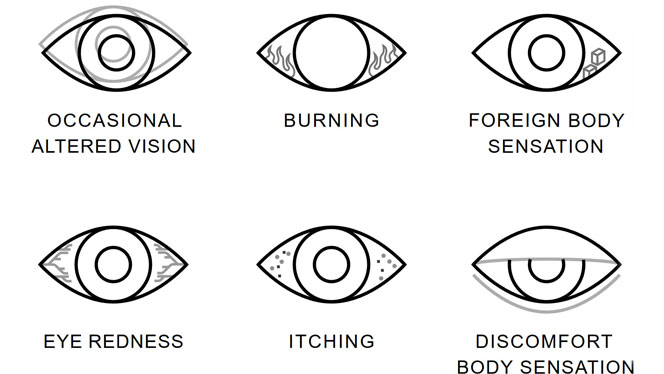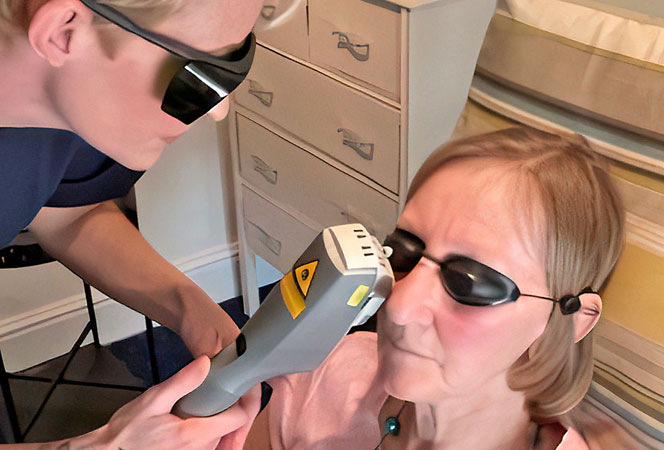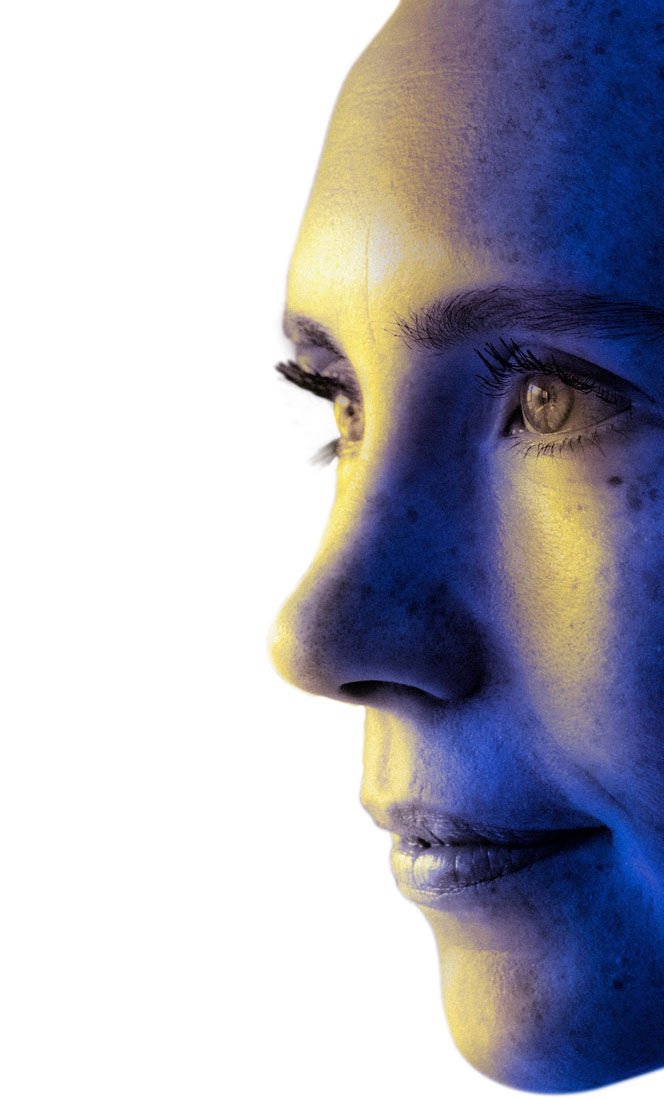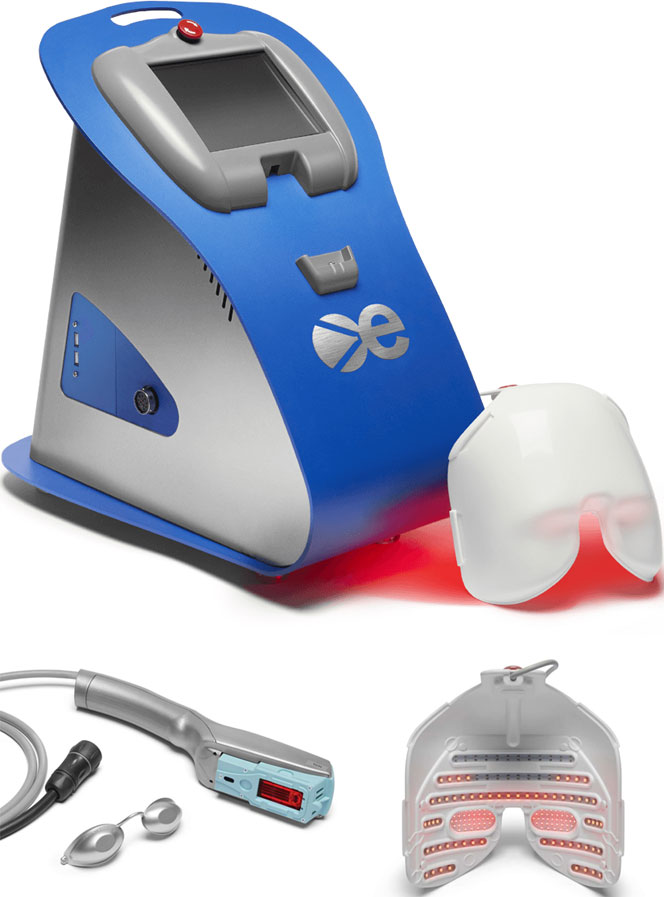
Do you have any of these symptoms?
- Occasional Altered Vision
- Burning
- Foreign Body Sensation
- Eye Redness
- Itching
- Discomfort Body Sensation
In addition to the above symptoms, do you suffer from some facial rosacea?

In addition to the above symptoms, do you suffer from some facial rosacea?

An increasing number of people worldwide suffer from dry eye disease (DED), the result of which can have a detrimental effect on vision, quality of life and work productivity. One in five, and nearly 800 million people worldwide, suffer from DED. Over 50% of females over the age of 40, and over 90% of menopausal females, are thought to live with this condition. More recently, the condition has become more common in all ages and genders due to environmental factors, use of cosmetics and medications, excessive screen use (phones, tablets, computers), and underlying conditions such as blepharitis and Sjögren’s syndrome.
Blepharitis is inflammation of the eyelids. Sjögren's syndrome is a long-term condition that influences the parts of the body that produce fluids, so tears and saliva are affected. It can cause dry eyes, dry mouth, dry skin, tiredness and other symptoms. It's more common in women than men and may be linked to genetics, hormones or an autoimmune condition.
DED can be a debilitating long-term condition in which a lack of tears or poor tear quality leaves the eyes chronically dry, which can make them uncomfortable or painful, and can affect vision for up to 15% of the population with increasing age.
DED can affect vision for up to 20% of the population, especially with increasing age.
Dry eye symptoms are often described as a gritty, sore or feeling of a foreign body being present in the eye, but can also include redness, burning and itching. Sometimes there is sympathetic excessive watering of the eyes. Vision may also become blurred because a poor tear film (tear layer) affects the way light behaves as it enters the eye.

There are several factors that can cause or contribute to dry eye disease.
90% of dry eye cases are related to meibomian gland dysfunction (MGD) which causes problems with the oil layer of the tear film on the eye. MGD occurs when the meibomian glands in the eyelids do not function normally. The meibomian glands produce oil that forms part of the tear film. The oily layer prevents the tears from evaporating, and lubricates the surface of the cornea (the front surface of the eye). The lipid-rich secretion from the glands is called meibum, and it reduces tear evaporation and help keeps the tear film stable. Insufficient or poor-quality oil causes tears to evaporate quickly, leaving the eye dry.
Any obstruction or malfunction of the meibomian glands prevents sufficient secretion of meibum, which affects the quality and texture of the meibum produced. An insufficient or absent lipid layer can result in tear film evaporation up to 16 times faster than normal.
Paradoxically, there may be excessive tears or watering of the eyes, with significant blurring of vision. Although the tears may be plentiful, they are the eye's (ineffective) way of trying to compensate for a defective oily layer in the tear film.
Patients with MGD often have abnormally dilated blood vessels (telangiectasia) along the eyelid margins. These dilated vessels are a source of increased inflammation.
Risk Factors for Dry Eye
Symptoms of MGD
Until recently, DED sufferers would be given an individualised eye treatment plan formulated during an assessment of the patient's Dry Eye Disease. The plan would take account of the identified cause(s), the severity of symptoms and lifestyle factors.
Traditionally recommended treatments may include:
Now, though, Dr Janjua can offer two specialised new treatments to alleviate the symptoms of DED, by improving secretion of meibum oil and its quality.
If you’ve been diagnosed with DED, and you’re fed-up with using warm compresses on your eyes, book now to see Dr. Janjua after you’ve read the information below describing our new effective treatment for DED.
Here's what you need to know before you book your appointment to see Dr Janjua.

Combined IPL and LLLT treatment
Optimal Power Energy® Intense Pulsed Light (IPL) treatment is a polychromatic light applied in thermal pulses below the lower lashes and cheekbone areas. IPL stimulates contraction of the meibomian glands, and selectively encourages regression of the abnormal blood vessels (telangiectasia) in the eyelids that contribute to the inflammatory cycle of MGD. It is a pain-free and effective way to treat dry eye conditions related to MGD, improving tear quality and other symptoms reported by patients.
IPL was originally created to treat facial rosacea, which is characterised by excessive superficial blood vessels (telangiectasia). Light energy is absorbed by these abnormal blood vessels and turned into heat, which then destroys them. An incidental finding by an eminent dermatologist has changed the lives of many people with significant improvement in dry eye symptoms.
IPL is combined with Light Modulation® Low-level Light Therapy (LLLT), a unique, light-based photobiomodulation (PBM) technology. Developed originally by NASA, LLLT has proved effective in treating the main cause of Dry Eye Disease: meibomian gland dysfunction.
LLLT is different from Red Light Therapy: LM®LLLT treats deeper into the cellular level to treat dry eye disease and meibomian gland dysfunction, repairing and improving meibum quality. Additionally, photoactivation of the cells promotes heating from within the glands (endogenous heating) thereby encouraging better meibum flow. This technology has been used for many years in various fields of medicine (e.g. dermatology, dentistry).
The emission of light at a specific wavelength triggers an internal heating effect of the eyelids. This improves cellular activity and eases the spill of the tear film’s oily component from the Meibomian glands, hence stabilising the lipid layer and providing immediate relief. A useful benefit is that this treatment works on both the upper and lower eyelids.
Dr Janjua’s treatments uses both core technologies for the effective treatment of Dry Eye Diseasen and Meibomian Gland Dysfunction (MGD) . Our patients now have access to an effective and safe clinic-based treatment for their symptoms. Simply put, IPL and LLLT treatment opens up the meibomian glands and liquifies the oil within the glands. Each of the two treatments has its own benefits, but they give even better results when they are used in combination.
This new therapy for Dry Eye Disease is safe, non-invasive, painless—and doesn’t involve any eyedrops. This revolutionary new treatment helps the meibomian glands to work properly and therefore stabilises and improves the quantity and quality of the oily layer of the tear film. The treatment provides an immediate relief of symptoms.
IPL (intense pulsed light) treatment combined with LLLT (low level light therapy) is a pain-free and effective way to treat dry eye conditions related to meibomian gland disease. This technique can also treat recurrent styes and chalazion (cysts) of the eyelids.
It’s quick and painless! Simply lay back with the the treatment mask in position and relax as the warm light clears the meibomian glands in your eyelids.
To manage Dry Eye Disease long term, only a few sessions are usually needed: from 1 to 4, depending on the severity, delivered over a period of 5 to 10 days, ultimately achieving an optimum result.
We encourage patients suffering with the symptoms of dry eye disease to book in to see Dr. Janjua for an initial consultation.
Remember IPL combined with LLLT is a completely painless and safe treatment. Due to the lower energy levels, this treatment can be offered to a much wider range of patients of all Fitzpatrick skin types. This technology enables us to provide a treatment option all skin types. Our treatments are quick and painless! You have only to lie back comfortably, with the treatment mask in position, and relax as the warm light clears your Meibomian glands.
To manage Dry Eye Disease long term, only a few sessions are usually needed: from 1 to 4, depending on the severity, delivered over a period of 5 to 10 days, ultimately achieving an optimum result.
Most patients notice an improvement only a few hours after the first treatment.
Chronically dry eyes are not only uncomfortable; there’s also a risk of damage to the cornea (the front of the eye), and atrophy (wasting away) of the meibomian glands which produce the oil component of your tears. Treatment is essential.
Artificial tears, eye drops, and other home treatments are time-consuming and tend to offer only limited and short-term relief. IPL with LLLT gives you long-term relief by treating the underlying triggers of dry eyes/blepharitis, rather than the symptoms.
Although it is particularly effective where the underlying cause of dry eyes is rosacea, it also treats several other causes, e.g. Demodex mite infestation, as well as meibomian gland dysfunction in general. IPL with LLLT treats blepharitis and destroys Demodex and reduces the recurrence of chalazions (eyelid cysts) and styes, and can help to keep the eyes clean before major eye surgery, or cataract or refractive surgery, and help with the healing afterwards.
Blepharitis
The term blepharitis refers to inflammation of the eyelid. The lids become red and irritated with dandruff- like scales forming on the eyelashes.
Back or Posterior Part of the Eyelid
The type of blepharitis which involves the back or posterior part of the eyelid is caused by MGD. Sometimes it occurs secondary to rosacea, but it can also happen with no apparent underlying causes. In older people, blepharitis is mostly caused by demodex mite infestation.
Demodex Folliculorum (tiny mites)
Infestation by Demodex mites is one of the causes of blepharitis and meibomian gland disease. Small numbers of demodex mites usually live in the base on the eyelash follicle, coming out at night to feed off dead skin cells and usually causing no harm. However, if numbers increase too much or they live in the meibomian glands, they can create problems. Eggs in the follicles can stretch them, leading to misdirected eyelashes. Deposits on the eyelashes leave them sticky or crusty and irritate the eyelids. These deposits also release toxins which trigger an inflammatory response.
When the mites live in the meibomian glands, they cause meibomian gland disease. The oil glands in the lids can become blocked, causing dry and sore eyes. Older people and those with rosacea tend to have greater numbers of demodex mites, making them more prone to blepharitis.
Demodex exoskeleton absorbs the light energy from the IPL and LLLT. High levels of Demodex are associated with increased bacteria on the eyelids, driving inflammation of the meibomian glands. By eradicating Demodex, this inflammation is reduced which in turn can help with Blepharitis.
For maintenance of eyelid hygiene, Dr Janjua recommends drops which incorporate manuka honey. In addition, for easy regular ‘at home’ lid hygiene, he suggests using products derived from Tea Tree Oil or which use patented hygiene systems based on okra (a plant also known as "Lady's Fingers").
IPL (Intense Pulsed Light) treatment combined with LLLT (low level light therapy) is a pain-free and effective way to treat dry eye conditions related to MGD. This technique can not only treat Dry Eye Disease and Meibomian Gland Dysfunction, but also recurrent styes and chalazions (cysts) of the eyelids.